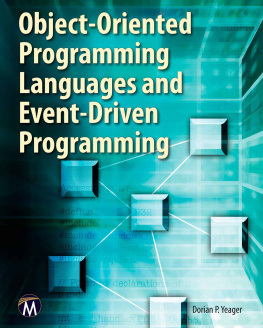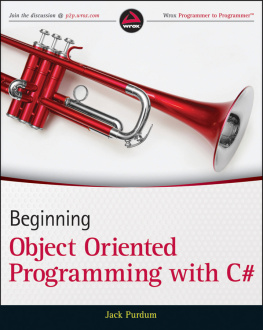Object-Oriented Programming in C++, Fourth Edition
Robert Lafore

800 East 96th St., Indianapolis, Indiana 46240 USA
Copyright 2002 by Sams Publishing
All rights reserved. No part of this book shall be reproduced, stored in a retrieval system, or transmitted by any means, electronic, mechanical, photocopying, recording, or otherwise, without written permission from the publisher. No patent liability is assumed with respect to the use of the information contained herein. Although every precaution has been taken in the preparation of this book, the publisher and author assume no responsibility for errors or omissions. Nor is any liability assumed for damages resulting from the use of the information contained herein.
Library of Congress Catalog Card Number: 2001094813
Printed in the United States of America
First Printing: December 2001
Seventh Printing with corrections: February 2005
08 07 06 13 12 11 10 9 8
EXECUTIVE EDITOR
Michael Stephens
ACQUISITIONS EDITOR
Michael Stephens
MANAGING EDITOR
Matt Purcell
PROJECT EDITORS
Angela Boley
Christina Smith
INDEXER
Rebecca Salerno
PROOFREADER
Matt Wynalda
TECHNICAL EDITOR
Mark Cashman
TEAM COORDINATOR
Pamalee Nelson
MEDIA DEVELOPER
Dan Scherf
INTERIOR DESIGNER
Gary Adair
COVER DESIGNER
Alan Clements
PAGE LAYOUT
Ayanna Lacey
Trademarks
All terms mentioned in this book that are known to be trademarks or service marks have been appropriately capitalized. Sams Publishing cannot attest to the accuracy of this information. Use of a term in this book should not be regarded as affecting the validity of any trademark or service mark.
Warning and Disclaimer
Every effort has been made to make this book as complete and as accurate as possible, but no warranty or fitness is implied. The information provided is on an as is basis. The author and the publisher shall have neither liability nor responsibility to any person or entity with respect to any loss or damages arising from the information contained in this book.
Bulk Sales
Sams Publishing offers excellent discounts on this book when ordered in quantity for bulk purchases or special sales. For more information, please contact
U.S. Corporate and Government Sales
1-800-382-3419
For sales outside of the U.S., please contact
International Sales
Dedication
This book is dedicated to GGL and her indomitable spirit.
Preface
.
Introducing the UML at the beginning allows the use of UML diagrams where they fit naturally with topics in the text, so there are many new UML diagrams throughout the book. The section on inter-file communication gathers together many concepts that were previously scattered throughout the book. The industrys approach to object-oriented analysis and design has evolved since the last edition, and accordingly weve modified the chapter on this topic to reflect recent developments.
C++ itself has changed very little since the last edition. However, besides the revisions just mentioned, weve made many smaller changes to clarify existing topics and correct typos and inaccuracies in the text.
About the Author
Robert Lafore has been writing books about computer programming since 1982. His best-selling titles include Assembly Language Programming for the IBM PC, C Programming Using Turbo C++, C++ Interactive Course, and Data Structures and Algorithms in Java. Mr. Lafore holds degrees in mathematics and electrical engineering, and has been active in programming since the days of the PDP-5, when 4K of main memory was considered luxurious. His interests include hiking, windsurfing, and recreational mathematics.
Acknowledgments to the Fourth Edition
My thanks to many readers who e-mailed comments and corrections. I am also indebted to the following professors of computer science who offered their suggestions and corrections: Bill Blomberg of Regis University in Denver; Richard Daehler-Wilking of the College of Charleston in South Carolina; Frank Hoffmann of the Royal Institute of Technology in Sweden, and David Blockus of San Jose State University in California. My special thanks to David Topham of Ohlone College in Fremont, California, for his many detailed ideas and his sharp eye for problems.
At Sams Publishing, Michael Stephens provided an expert and friendly liaison with the details of publishing. Reviewer Robin Rowe and Technical Editor Mark Cashman attempted with great care to save me from myself; any lack of success is entirely my fault. Project Manager Christina Smith made sure that everything came together in an amazingly short time, Angela Boley helped keep everything moving smoothly, and Matt Wynalda provided expert proofreading. Im grateful to you all.
Acknowledgments to the Third Edition
Id like to thank the entire team at MacMillan Computer Publishing. In particular, Tracy Dunkelberger ably spearheaded the entire project and exhibited great patience with what turned out to be a lengthy schedule. Jeff Durham handled the myriad details involved in interfacing between me and the editors with skill and good humor. Andrei Kossorouko lent his expertise in C++ to ensure that I didnt make this edition worse instead of better.
Acknowledgments to the Second Edition
My thanks to the following professorsusers of this book as a text at their respective colleges and universitiesfor their help in planning the second edition: Dave Bridges, Frank Cioch, Jack Davidson, Terrence Fries, Jimmie Hattemer, Jack Van Luik, Kieran Mathieson, Bill McCarty, Anita Millspaugh, Ian Moraes, Jorge Prendes, Steve Silva, and Edward Wright.
I would like to thank the many readers of the first edition who wrote in with corrections and suggestions, many of which were invaluable.
At Waite Group Press, Joanne Miller has ably ridden herd on my errant scheduling and filled in as academic liaison, and Scott Calamar, as always, has made sure that everyone knew what they were doing. Deirdre Greene provided an uncannily sharp eye as copy editor.
Thanks, too, to Mike Radtke and Harry Henderson for their expert technical reviews.
Special thanks to Edward Wright, of Western Oregon State College, for reviewing and experimenting with the new exercises.
Acknowledgments to the First Edition
My primary thanks go to Mitch Waite, who poured over every inch of the manuscript with painstaking attention to detail and made a semi-infinite number of helpful suggestions.
Bill McCarty of Azusa Pacific University reviewed the content of the manuscript and its suitability for classroom use, suggested many excellent improvements, and attempted to correct my dyslexic spelling.
George Leach ran all the programs, and, to our horror, found several that didnt perform correctly in certain circumstances. I trust these problems have all been fixed; if not, the fault is entirely mine.
Scott Calamar of the Waite Group dealt with the myriad organizational aspects of writing and producing this book. His competence and unfailing good humor were an important ingredient in its completion.
I would also like to thank Nan Borreson of Borland for supplying the latest releases of the software (among other useful tidbits), Harry Henderson for reviewing the exercises, Louise Orlando of the Waite Group for ably shepherding the book through production, Merrill Peterson of Matrix Productions for coordinating the most trouble-free production run Ive ever been involved with, Juan Vargas for the innovative design, and Frances Hasegawa for her uncanny ability to decipher my sketches and produce beautiful and effective art.








